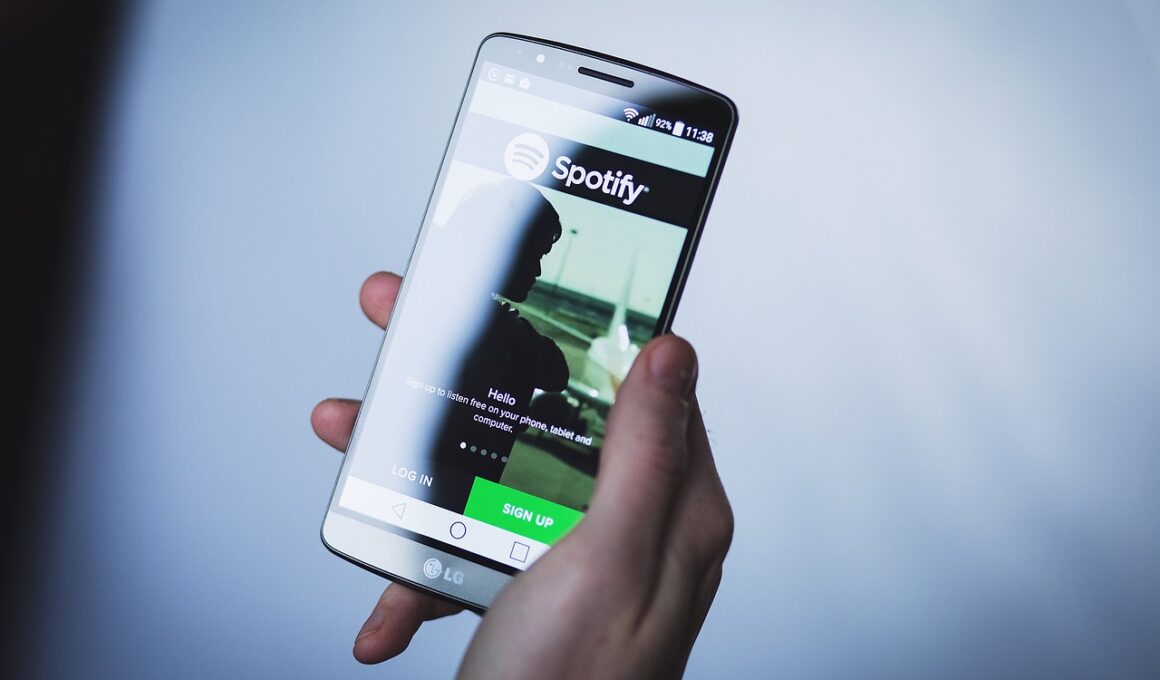Data-Driven Mobile Marketing: How ‘Spotify’ Uses Analytics
Mobile marketing has become an essential practice for brands striving to connect with their audience effectively. In today’s landscape, several companies have embraced analytics to enhance their marketing strategies, and Spotify stands out as a leader in this regard. By leveraging data, Spotify tailors its marketing efforts to resonate with individual listeners. This customization enhances user satisfaction and drives user engagement, crucial elements in the competitive music streaming sector. Data plays a pivotal role in guiding Spotify’s decisions, allowing for targeted campaigns that reflect user preferences. The application of analytics enables Spotify to analyze listening habits and understand which genres or artists captivate their audience. Ultimately, this insight translates into personalized playlists and recommendations delivered through their mobile app. This personalized approach nurtures loyalty and keeps users returning to the platform. Furthermore, by tracking user interactions, Spotify can assess the performance of their campaigns and improve future initiatives. Analytics transforms raw data into actionable insights, shaping Spotify’s approach to engaging users effectively. The overarching strategy enhances both brand visibility and user experience in the mobile arena.
One key aspect of Spotify’s mobile marketing strategy is the use of segmented data analysis. By categorizing their audience based on demographics, behavior, and preferences, Spotify can create customized marketing messages. For instance, a user who consistently listens to indie rock will receive tailored promotional content focusing on new indie releases or concerts featuring similar artists. This segmentation is critical for ensuring marketing efforts resonate with target users. Furthermore, by employing A/B testing, Spotify can evaluate which marketing messages yield better performance metrics. Such testing involves sending different campaign variations to segmented user groups and analyzing engagement results. This iterative approach allows Spotify to refine their content and advertising strategies continually. The effectiveness of these campaigns is measured through click-through rates, conversion metrics, and overall user engagement. Understanding the direct impact of different marketing tactics enables Spotify to allocate resources effectively. Moreover, by analyzing retention rates, Spotify can identify users at risk of leaving the platform and introduce incentives to retain them. Thus, analytics creates a feedback loop that informs and strengthensSpotify’s mobile marketing strategies.
Another way Spotify embraces analytics in mobile marketing is through the use of immersive storytelling. By utilizing engaging narratives within their advertising campaigns, Spotify can create emotional connections with users. For instance, user-generated playlists are often highlighted in ads, showcasing real listener experiences. This strategy not only captivates potential listeners but also strengthens community engagement. Spotify amplifies these stories through various channels, particularly social media, where users share their playlists and music experiences. By resharing this user-generated content, Spotify enhances its brand authenticity. Furthermore, the platform analyzes social media interactions to gauge audience sentiment towards campaigns and brand perception. Through sentiment analysis, Spotify can determine how users feel about musical trends and targeted promotions. This feedback is crucial for adjusting marketing strategies to improve brand alignment with audience expectations. Besides traditional metrics, tracking engagement on social media platforms presents a comprehensive view of campaign performance. Using these insights, Spotify can optimize its approach to reach users more effectively and create impactful content requests that will resonate across diverse audience segments.
Geolocation and Event-Based Marketing
Spotify also employs geolocation data to enhance their mobile marketing strategies. By understanding where users are located, Spotify can tailor promotions to regional events and local artists. For example, if there is a music festival in a certain city, Spotify might promote artists performing at that event in the targeted area. This localized approach not only boosts engagement but also helps users feel more connected to their musical community. Additionally, Spotify analyzes event data to create notifications for users about upcoming concerts or related experiences. Users appreciate receiving these updates, leading to higher interaction rates. The platform’s ability to inform listeners about nearby events relies heavily on analytics. This strategy fosters a sense of urgency and personal involvement, encouraging users to participate actively. Moreover, geolocation data aids in the customization of playlists based on local preferences. For instance, trending songs in a user’s region might be highlighted in their recommendations. This means the music Spotify promotes is relevant to a user’s geographical and cultural context, providing a richer listening experience. Consequently, blending geolocation insights enhances Spotify’s engagement effectiveness.
Data-driven insights also enable Spotify to strategically plan content releases. By analyzing listening trends over time, the platform identifies peak listening hours and popular tracks among different user segments. This data informs the timing of album releases and promotional campaigns. For instance, if analytics reveal that listeners are more active during weekends, Spotify can schedule promotional ads for Friday nights, aligning with user behavior. Content timing is essential for maximizing visibility and engagement, especially in the fast-paced music industry, where trends shift rapidly. Additionally, Spotify’s focus on user data allows the company to anticipate future music trends and artist popularity. This predictive analysis is instrumental for record labels and artists seeking better placement on Spotify’s platform. Artists can leverage this data to guide their own marketing strategies effectively. With this approach, Spotify positions itself as a valuable partner in the music business ecosystem. This forward-thinking mindset fosters collaboration between Spotify and artists, creating opportunities for innovation and engagement. As these partnerships evolve, the overall user experience on the platform improves significantly.
Conclusion
In summary, Spotify exemplifies how data and analytics are reshaping mobile marketing strategies. By embracing mobile marketing techniques driven by data insights, Spotify has established itself as a frontrunner in the competitive music streaming landscape. The platform’s approach to audience segmentation, immersive storytelling, and geolocation marketing showcases the power of tailored content. Data has proven to be a critical asset that informs decisions and enhances audience engagement. As Spotify continues to grow, its commitment to utilizing analytics for mobile marketing will likely evolve with new technologies and trends. By staying ahead of the curve, Spotify maintains a strong connection with users, ensuring their experience remains relevant and enjoyable. As the music industry changes and digital preferences shift, so too will Spotify’s strategies. Their adaptive nature is a demonstration of how brands can harness data to create dynamic marketing campaigns that resonate. The ongoing utilization of analytics highlights the importance of being responsive to audience needs, preferences, and behaviors, further solidifying Spotify’s place in the market. Ultimately, the future of mobile marketing, particularly in music streaming, will be shaped by the insights and data that companies like Spotify leverage effectively.
As other industries learn from Spotify’s success, we can anticipate a broader adoption of data-driven marketing strategies. Businesses are recognizing the need to leverage analytics to enhance their outreach and engagement efforts, making data insights a priority. The positive impact of personalized marketing experiences is evident in Spotify’s results, highlighting that when brands focus on understanding their audience, they drive higher levels of satisfaction. Companies venturing into mobile marketing can take cues from Spotify’s methodologies, optimizing their strategies to connect more profoundly with their audiences. The emphasis on analytics and feedback ensures that campaigns are constantly improving, adapting to the dynamic nature of consumer behavior. As a result, organizations can expect ongoing growth and heightened brand loyalty by placing data at the forefront of their marketing initiatives. In conclusion, Spotify’s use of analytics underscores the disruptive potential of technology in marketing. As data becomes increasingly accessible, the opportunities for brands to create meaningful connections with their audiences are limitless. Harnessing this potential allows brands to thrive in an ever-evolving digital landscape, ensuring long-term success and relevance.


